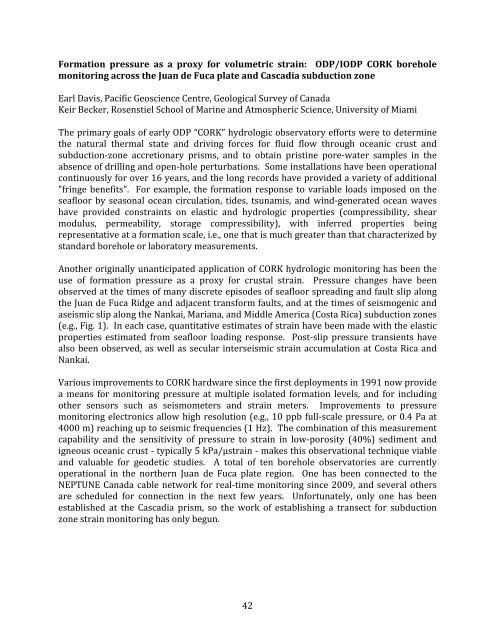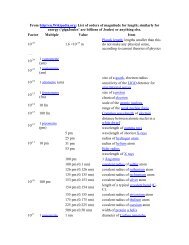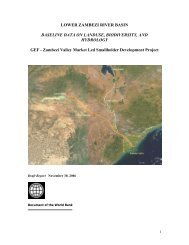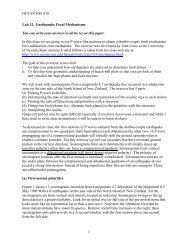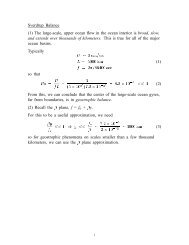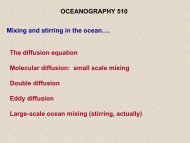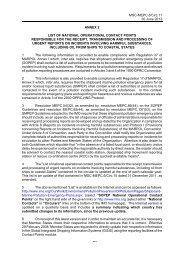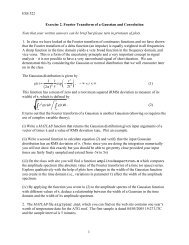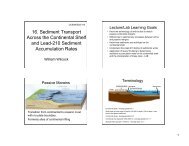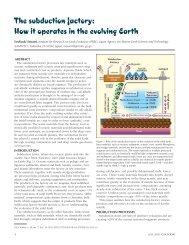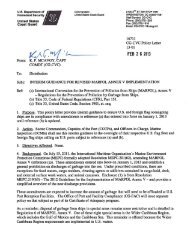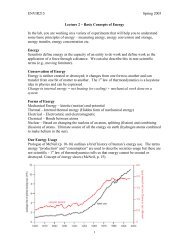2012 Seafloor Geodesy in Cascadia - William Wilcock - University of ...
2012 Seafloor Geodesy in Cascadia - William Wilcock - University of ...
2012 Seafloor Geodesy in Cascadia - William Wilcock - University of ...
Create successful ePaper yourself
Turn your PDF publications into a flip-book with our unique Google optimized e-Paper software.
Formation pressure as a proxy for volumetric stra<strong>in</strong>: ODP/IODP CORK borehole <br />
monitor<strong>in</strong>g across the Juan de Fuca plate and <strong>Cascadia</strong> subduction zone <br />
Earl Davis, Pacific Geoscience Centre, Geological Survey <strong>of</strong> Canada <br />
Keir Becker, Rosenstiel School <strong>of</strong> Mar<strong>in</strong>e and Atmospheric Science, <strong>University</strong> <strong>of</strong> Miami <br />
The primary goals <strong>of</strong> early ODP “CORK” hydrologic observatory efforts were to determ<strong>in</strong>e <br />
the natural thermal state and driv<strong>in</strong>g forces for fluid flow through oceanic crust and <br />
subduction-‐zone accretionary prisms, and to obta<strong>in</strong> prist<strong>in</strong>e pore-‐water samples <strong>in</strong> the <br />
absence <strong>of</strong> drill<strong>in</strong>g and open-‐hole perturbations. Some <strong>in</strong>stallations have been operational <br />
cont<strong>in</strong>uously for over 16 years, and the long records have provided a variety <strong>of</strong> additional <br />
"fr<strong>in</strong>ge benefits". For example, the formation response to variable loads imposed on the <br />
seafloor by seasonal ocean circulation, tides, tsunamis, and w<strong>in</strong>d-‐generated ocean waves <br />
have provided constra<strong>in</strong>ts on elastic and hydrologic properties (compressibility, shear <br />
modulus, permeability, storage compressibility), with <strong>in</strong>ferred properties be<strong>in</strong>g <br />
representative at a formation scale, i.e., one that is much greater than that characterized by <br />
standard borehole or laboratory measurements. <br />
Another orig<strong>in</strong>ally unanticipated application <strong>of</strong> CORK hydrologic monitor<strong>in</strong>g has been the <br />
use <strong>of</strong> formation pressure as a proxy for crustal stra<strong>in</strong>. Pressure changes have been <br />
observed at the times <strong>of</strong> many discrete episodes <strong>of</strong> seafloor spread<strong>in</strong>g and fault slip along <br />
the Juan de Fuca Ridge and adjacent transform faults, and at the times <strong>of</strong> seismogenic and <br />
aseismic slip along the Nankai, Mariana, and Middle America (Costa Rica) subduction zones <br />
(e.g., Fig. 1). In each case, quantitative estimates <strong>of</strong> stra<strong>in</strong> have been made with the elastic <br />
properties estimated from seafloor load<strong>in</strong>g response. Post-‐slip pressure transients have <br />
also been observed, as well as secular <strong>in</strong>terseismic stra<strong>in</strong> accumulation at Costa Rica and <br />
Nankai. <br />
Various improvements to CORK hardware s<strong>in</strong>ce the first deployments <strong>in</strong> 1991 now provide <br />
a means for monitor<strong>in</strong>g pressure at multiple isolated formation levels, and for <strong>in</strong>clud<strong>in</strong>g <br />
other sensors such as seismometers and stra<strong>in</strong> meters. Improvements to pressure <br />
monitor<strong>in</strong>g electronics allow high resolution (e.g., 10 ppb full-‐scale pressure, or 0.4 Pa at <br />
4000 m) reach<strong>in</strong>g up to seismic frequencies (1 Hz). The comb<strong>in</strong>ation <strong>of</strong> this measurement <br />
capability and the sensitivity <strong>of</strong> pressure to stra<strong>in</strong> <strong>in</strong> low-‐porosity (40%) sediment and <br />
igneous oceanic crust -‐ typically 5 kPa/µstra<strong>in</strong> -‐ makes this observational technique viable <br />
and valuable for geodetic studies. A total <strong>of</strong> ten borehole observatories are currently <br />
operational <strong>in</strong> the northern Juan de Fuca plate region. One has been connected to the <br />
NEPTUNE Canada cable network for real-‐time monitor<strong>in</strong>g s<strong>in</strong>ce 2009, and several others <br />
are scheduled for connection <strong>in</strong> the next few years. Unfortunately, only one has been <br />
established at the <strong>Cascadia</strong> prism, so the work <strong>of</strong> establish<strong>in</strong>g a transect for subduction <br />
zone stra<strong>in</strong> monitor<strong>in</strong>g has only begun. <br />
42


